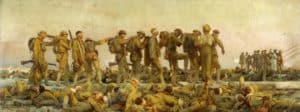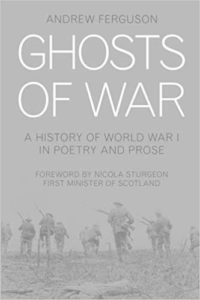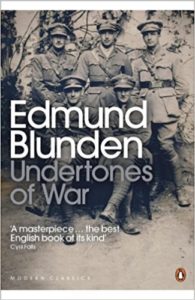Sunday marks the 100th anniversary of the end of World War I. The war that was supposed to be over by Christmas (of 1914) lasted four and a half years. Ten million military personnel and almost 7 million civilians died. The Habsburg, Romanov, and Hohenzollern empires ended. The Russian Revolution started, with millions more killed over the next four to five years. Even the victorious nations in Europe faced dire financial conditions, broad disillusionment, and the loss of a generation because of the war.
Poetry changed as well. People’s understanding of the war was partially shaped by poetry, and the patriotic poems of the first year of war, like Rupert Brooke’s “The Soldier” and Alan Seeger’s “I Have a Rendezvous with Death,” gradually gave way to poems like Wilfred Owen’s “Anthem for Doomed Youth.”

Gassed by John Singer Sargent, Imperial War Museum
The forms of poetry also changed during the war. While most war poems followed traditional and formal forms, it was in 1915 that Poetry Magazine published T.S. Eliot’s “The Love Song of J. Alfred Prufrock,” considered by many to have inaugurated the birth of modernism in poetry. It was perhaps no coincidence that Eliot was a transplanted American living in wartime London when he wrote the poem.
Because the last four years have marked the centennial of the war, an abundance of books about the war and the poetry of the war have been published. We’ve reviewed many of them here at Tweetspeak Poetry. Here are some of the best.
Anthem for Doomed Youth: Twelve Soldier Poets of the First World War by Jon Stallworthy summarizes the lives of 12 leading war poets in photographs, poems, and text. It’s an engaging overview of the leading British poets of the war. Tim Kendall’s The Poetry of World War I—An Anthology is exactly that, a well-rounded collection of the work of British poets. And Up the Line to Death: The War Poets 1914-1918 by Brian Gardner is another fine compilation and anthology.

Three books take World War I poetry, and the war itself, into a deeper understanding. Mary Egremont’s Some Desperate Glory: The First World War the Poets Knew details the war as experienced by the men who wrote the poetry. The poetry most read by the soldiers themselves was A Shropshire Lad by A.E. Housman. And writer Peter Parker explores A Shropshire Lad in scholarly depth and research in Housman Country: Into the Heart of England.
One of the most acclaimed memoirs of the war, published a decade after the war’s end, was Edmund Blunden’s Undertones of War, which includes not only a day-to-day account of his life at the Western Front but also all of the war poems he wrote. When it was published in 1928, the publisher believed it wouldn’t be popular and printed only a limited number of copies. The book went through seven editions in its first year, and it has been called a masterpiece of the war memoir. Blunden pulls no punches; the brutality, horror, and stupidity of the war can be found in both the memoir and the poems.

The war’s centennial has inspired more than the publications of books. London’s Imperial War Museum opened the permanent World War I Galleries, which cover everything from a diary of the German invasion of Belgium through the signing of the surrender treaty on Armistice Day—and provide the opportunity to visit a trench at the front (minus the mud and the lice). And the dramatic public art installation of Blood Swept Lands and Seas of Red from July through November of 2014 in the Tower of London moat may rank as one of the best war memorials of all time. Almost 900,000 ceramic poppies eventually were placed in the moat, one for each British and colonial casualty of the war. You can see pictures of the installation and even track where a lot of the poppies ended up (including one at my home in St. Louis).
World War I, called The Great War in its own time, was believed to be the war to end all wars. It was not to be. It brought convulsive change to much of the world. It was chronicled by poetry to a remarkable extent, and it changed poetry to an equally remarkable extent. Poetry has experienced no war like it, before or since.
Photo by Dominic Alves, Creative Commons, via Flickr. Post by Glynn Young, author of the novels Dancing Priest, A Light Shining, Dancing King, and the newly published Dancing Prophet, and Poetry at Work.
__________________________

“I require all our incoming poetry students—in the MFA I direct—to buy and read this book.”
—Jeanetta Calhoun Mish
- “Horace: Poet on a Volcano” by Peter Stothard - September 16, 2025
- Poets and Poems: The Three Collections of Pasquale Trozzolo - September 11, 2025
- Poets and Poems: Boris Dralyuk and “My Hollywood” - September 9, 2025

Sandra Heska King says
Oh, those poppies… I think I remember you wrote about them before.
I’ve been reading a lot of Anna Akhmatova recently and how her poetry, as well as that of other Russian poets, changed with the start of the war. The Stray Dog where they used to hang out closed, and their words were censored or hushed altogether.
In Memoriam, July 19, 1914
We aged a hundred years and this descended
In just one hour, as at a stroke.
The summer had been brief and now was ended;
The body of the ploughed plains lay in smoke.
The hushed road burst in colours then, a soaring
Lament rose, ringing silver like a bell.
And so I covered up my face, imploring
God to destroy me before battle fell.
And from my memory the shadows vanished
Of songs and passions—burdens I’d not need.
The Almighty bade it be—with all else banished—
A book of portents terrible to read.
Glynn says
The lives of most of the Russian poets of the period didn’t end well. Her life became a struggle under the Soviet regime. Her husband was executed in 1921, she couldn’t publish her poetry (she relied on translation work to survive), and her son was arrested in the 1930s and, while released, wasn’t allowed to be published or do academic work because of who his parents were. But she continued to write; you can’t stop a poet from being a poet.
Laura Brown says
“You can’t stop a poet from being a poet.” That reminds me of Heather McHugh’s poem “What He Thought” about Giordano Bruno, a victim of an ideological war.
https://www.poetryfoundation.org/poems/50609/what-he-thought
Katie says
Laura,
Thank you for sharing this poem.
I found it arresting, convicting.
Truly an admonishment to be “quick to hear and slow to speak.”
Gratefully,
Katie
Dave Malone says
Thanks for this post, Glynn. Brooke’s “Soldier” is very moving–and refreshing in its language and poignancy, and not as sentimental as Seeger’s. Glad you shared all of these links out to the poems and to the book reviews. And I am definitely adding Edmund Blunden’s Undertones of War to my reading list.
Will Willingham says
I always love seeing the images of all those poppies. How cool that you have one. 🙂
Glynn says
I ordered one, hoping that I’d be able to surprise my wife. But it took several months for the poppy exhibition organizers to get everything together, including the cleaning of each poppy. My wife was seeing stories about the available poppies being sold out, and mentioned that it would be wonderful to have one. She saw the look on my face and guessed that I’d ordered one.